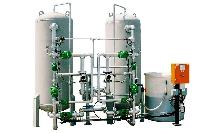
Water Softener Plant
1 Piece(s) (MOQ)
We are an established Supplier and Exporter of Water Softener Plant from Tamil Nadu. The Water Softener Plant we make available is known for its long functional life, high efficiency and reliable performance. To meet the bulk and urgent requirements of the buyers, we maintain a large stock of the Softener Plants in our spacious warehouse. The entire range of the Softener Plant is reasonably priced by us.
Color : Blue and Yellow
Type : Vertical Softener
...more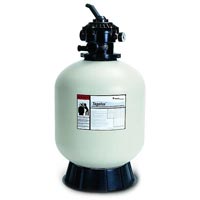
Pressure Sand Filter
1 Piece(s) (MOQ)
Our Pressure Sand Filters are highly recommended by industry experts for easy removal of suspended solids and undisclosed impurities from water. Designed using advanced technology, our Pressure Sand Filter is an ideal solution for the systems with high sediment, silt and sand. We are a renowned Supplier and Exporter of Sand Filters from Tamil Nadu. Bulk orders of the Sand Filters are processed by us as per the specific requirements of the buyers.
...more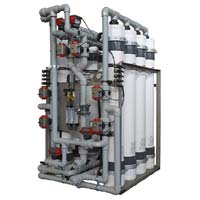
Ultra Filtration System
Description of Technology MF has the largest pore size (0.1 – 3 microns) of the wide variety of membrane filtration systems. UF pore sizes range from 0.01 to 0.1 micron. In terms of pore size, MF fills in the gap between ultrafiltration and granular media filtration. In terms of characteristic particle size, this MF range covers the lower portion of the conventional clays and the upper half of the range for humic acids. This is smaller than the size range for bacteria, algae and cysts, and larger than that of viruses. MF is also typically used for turbidity reduction, removal of suspended solids, giardia and cryptosporidum. UF membranes are used to remove some viruses, color, odor, and some colloidal natural organic matter [1]. Both processes require low transmembrane pressure (1–30 psi) to operate, and both are now used as a pretreatment to desalination technologies such as reverse osmosis, nanofiltration, and electrodialysis [1]. MF membranes can operate in either crossflow separation or dead-end filtration. Cross flow separation is where only part of the feed stream is treated and the remainder of the water is passed through the membrane untreated. In dead-end separation, all of the feed water is treated. There are also two pump configurations, either pressure driven or vacuum-type systems. Pressure driven membranes are housed in a vessel and the flow is fed from a pump. Vacuumtype systems are membranes submerged in non-pressurized tanks and driven by a vacuum created on the product side. Typical recoveries can range from 85% to 95% [2]. Flux rates range from 20 to 100 gpd/ft2 depending on the application. Backwashes are usually carried out for short durations (3 to 180 s) and occur in relatively frequent intervals (5 min to several hours) [2]. The frequency and duration depend on the specific application. A clean in place (CIP) can also be performed as a periodic major cleaning technique. Typical cleaning agents are sodium hypochlorite, citric acid, caustic soda and detergents. They can be initiated manually, and automatically controlled. CIP’s occur when backwashing and chemically enhanced backwashes are not sufficient enough. Factors influencing membrane selection are, cost, percent recovery, percent rejection, raw water characteristics, and pretreatment requirements. Factors influencing performance are raw water characteristics, trans-membrane pressure, temperature, and regular monitoring and maintenance. Pretreatment A self backwashing 100 um strainer is often necessary to protect the membranes and moderate particulate loading. Depending on the raw water, a coagulant such as ferric chloride may be added to form pinfloc and help improve rejection. Maintenance It is necessary to monitor filtrate turbidity to give a rough indication of membrane integrity. Membrane integrity can be tested through a pressure decay test. In this test, pressurized air is applied to the membranes at a pressure less than would cause the air to flow through the membrane, and the pressure decay is measured. Regular monitoring of membrane performance is necessary to ensure the membrane system is operating at the most effective loading rate and backwash regime. Membrane life is typically estimated at 7+ years with manufacturer warranties covering 5 years. Waste Disposal Waste includes pretreatment waste, backwash flow, retentate flow (if applicable), and CIP waste. Waste streams are either discharged to the sewer or treated if discharging to surface waters. Waste streams being discharged to surface waters are typically processed for turbidity removal through settling ponds or other treatment systems. CIP waste is neutralized and usually combined with the rest of the waste. Benefits • A low pressure process • Can typically produce water of satisfactory turbidity with feed waters exceeding 100 NTU. • MF and UF can receive state removal credits for Giardia and viruses up to 3 log and 4 log, respectively. However, virus removal is typically 0.5 log or less due to the smaller pore size of MF and UF.3
...more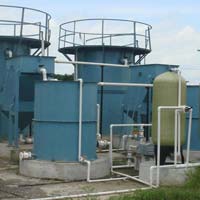
Sewage Treatment Plant
Sewage Treatment Plants are installed and commissioned at various industries for treating waste before discharging them into water bodies. The plant receives the waste from domestic, commercial and industrial sources and removes the harmful materials from the sewage that damage water quality. The prime objective of a sewage treatment plant is to make the industrial effluents free from elements that are harmful for human and environment. Working Principle Preliminary Treatment: Removal of coarse solids and other large materials found in raw wastewater Primary Treatment: Removal of settle-able organic and inorganic solids by sedimentation, and the removal of float-able materials by skimming Secondary Treatment: Removal of residual organics and suspended solids Application All these sewage treatment plants are used for treating sewage and effluents coming out from commercial establishments, residential areas and industries.
...more
Reverse Osmosis Plant
1 Piece(s) (MOQ)
The RO System works on the principle of Reverse osmosis, also known as hyper-filtration. One of the finest techniques for treating water, reverse osmosis eliminates contaminants from water thus making it fit for drinking purpose and other commercial and industrial applications. The RO system is provided with sediment pre-filter and an activated carbon filter as the membranes are degraded by chlorine, bacterial attack, manganese, hydrogen sulfide and iron.
...more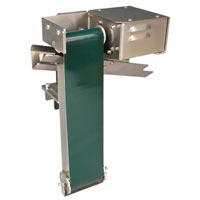
Oil Skimmer
Our company’s name figures in the list of renowned Suppliers and Exporters of Oil Skimmers from Tamil Nadu. The Oil Skimmers we make available are known for their reliable performance and durability. We source these Oil Skimmers from reliable vendors of the market. We are capable of delivering bulk orders of the Oil Skimmers within the stipulated time. Buyers can obtain the Skimmers at market-leading rates. Details : MOC : SS304 / SS316 Type : Belt Length : 20Inch to 60 Inch
...more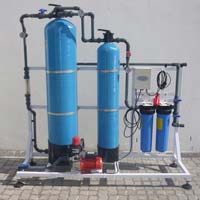
Iron Removal Filters
Iron is an objectionable constituent of portable water. Iron in water imparts a bitter characteristic, metallic taste and cause oxidized precipitate. Color of water, which may be yellowish brown to reddish brown, symbols the water objectionable or unsuitable for use. In addition to this, Iron stain everything with which it come in contact. Iron exists in water in two levels. One as the bivalent, Ferrous Iron (Fe ++) and the second one as the trivalent, Ferric Iron (Fe+++). The Ferric Iron generally occurs in the precipitated form. Iron forms complexes of hydroxides and other in-organic complexes in solution with substantial amount of bi-carbonate, sulphate, phosphate, cyanide or halides. Presence of organic substances induces the formation of organic complexes which increase the solubility of Iron. The waters of high alkalinity have lower iron than waters of low alkalinity. Causes of Iron:Iron contamination causes stains on your sinks and bathroom tiles. Stains appear on your faucets and fixtures. Pipes corrode washing machines, water heaters, dishwashers, steam irons, showers and radiators fall prey. Up to 50% of their life and efficiency gets reduced, adding up 25% in maintenance and running costs.If iron water is consumed it can cause loss of appetite and tissue damage. When used for bathing it causes skin rashes and hair loss. ron removal process description:Stage I - Chemical dosingTo level the pH factor, chemical pre treatment is done in order to facilitate rapid aeration than the chemical dosed water send in to the aeration tanksStage II- Online aeration Type Chemical dosed water is sent into the aeration tank consisting three chambers. The raw water is allowed to sprinkle at the first chamber through specially designed perforated pipes. The water travels from first chamber to other two chambers through accurately designed multiple vents at variable levels of the bifurcate walls, thus provides ZIG ZAG motion. When the water reaches the third chambers the dissolved iron gets oxides and become suspended iron.8 Hours Storage Aeration Type Chemical dosed water is pumped in to aeration tank. The raw water is allowed to sprinkle (at the tank/sump) via designed perforated pipes and allowed to remain there for about 8 to 10 hrs to get oxidized through the natural process and the iron presence in the water becomes suspended iron.Stage III - FiltrationThe suspended iron water is passed through Iron removal unit, the filter media is supported on gravel bed that consists of multiple layers of progressively larger sizes of manganese di oxide, activated carbon 900iv, graded quartz sand, fine sand, super fine white sand and pebbles, which retain the suspended iron particles. During the filtration cycle the filter bed retains the dirt and suspended particles from the water and accumulates within the filter bed.Backwash:As the filtration progress the filter media gets loaded with the retained particles, this results in a continuous increase of pressure drop across the filter, when a predetermined pressure drop level is achieved the filter is shut down for cleaning. After backwashing the filter is rinsed with raw water and after the quality of water is achieved the filter is put back into service.Product model:Our NONFERR iron removal plants comprise Mild Steel /SS / FRP Pressure Vessel, Frontal piping wok with manual/Automatic multi port valve butterfly valve/conventional valves for easy operation and control. Available from 1000 LPH to 1000000 LPH.
...more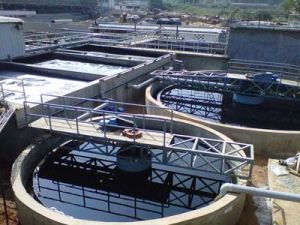
Effluent Treatment Plant
Effluent treatment systems are widely used for recycling of wastewater in industries in order to reduce the demand of water. This type of system uses physical, chemical, biological and membrane processes for treating the effluents before being discharged into the water. The effluent system is provided with all the requisite features that assist in achieving zero-discharge standards laid by statutory authority. Working Raw effluent is passed through Screening and Grit chamber for removal of floatable matter and sand, grit, stones After this, the effluent is passed through Oil & grease trap where floatable oil and grease is removed from raw effluent. Then the effluent is treated through primary treatment that includes chemical treatment like coagulation, flocculation and neutralization After primary treatment, the effluent is passed for secondary treatment that comprises of biological treatment for reduction of BOD/COD and solid-liquid separation Finally the tertiary treatment in which sand and carbon filtration is done for removal of suspended solids and organic material
...more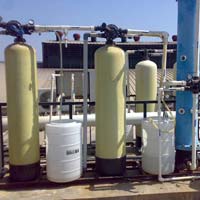
DM Plant
Demineralised Water systems produces high quality water free from any kind of minerals. It operates on the principle of ion exchange, degasification and polishing for treating water and removing ions. Demineralization technology is one of the cost effective solutions for treatment of water. These systems are widely used to treat water in the field of steam, power, process, and cooling Varieties of Demineralized Water Systems: Feed water is passed through two small polystyrene beds filled with ion exchange resins. The cations present in water get exchanged with hydrogen ions in first bed. And the anions are exchanged with hydroxyl ions, in the second bed. After the exchange, the quality of water is as follows: Cation quality - less than 10 Micro siemens per centimeters 7.5 to 8.5 pH Used as a polishing unit, the mixed bed has less than 1 micro siemens quality
...more
Ro Plant

Softener Plant

Water Purifier

Water Treatment Equipment

water treatment equipments

RO Plant Servicing
For reliable and effective RO Plant Servicing in Tamil Nadu, you can contact us. We have on board a team of brilliant professionals, who are second to none in this domain. Complete maintenance and repair of RO Plants are provided by us. We utilize advanced technology and machinery to render the services. Our workforce inspects and each and every component of the RO Plant for corrosion and other damages during the Servicing. Clients can obtain the Services at nominal rates.
...moreBe first to Rate
Rate This